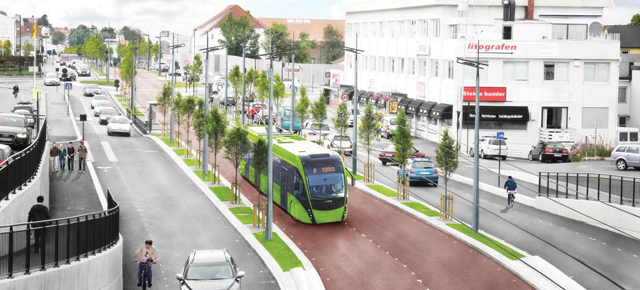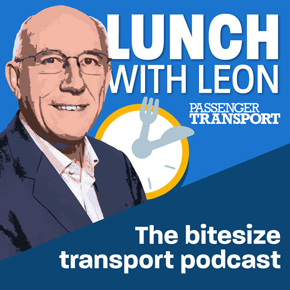Stavanger, a city roughly the size of Oxford, is building a 50km Bus Rapid Transit network. This massive £1.44bn project will be completed by 2030

By Robert Jack
Do you wish you could get support for bus priority on a core corridor in your town or city? Did your local authority miss out on a share of the funding available to support Bus Service Improvement Plans or equivalent funding schemes? Well you may go green with envy at the scale of ‘Bussveien’ – “Europe’s longest Bus Rapid Transit system” – in the Norwegian city of Stavanger.
Liz Helen Rosenkilde Christensen, architect at Rogaland fylkeskommune, public roads administration, offered insights into this epic project in the fourth of BRTuk’s Lunchtime Masterclasses last month.
Stavanger is Norway’s fourth largest city (145,000 people) and third largest metropolitan area (237,000 people), comparable in size to Oxford.
Bussveien has to be something more, and a better quality than all our bus rides in order to compete against cars
The region faces a number of transport challenges. This affluent region has urban sprawl and low density housing, a recipe for high car dependency and use. Consequently, Christensen said the public transport offering has to be as attractive as possible.
“There really are few incentives to make the shift from private cars to public transit,” she said. “Bussveien has to be something more, and a better quality than all our bus rides in order to compete against cars.”
Net zero ambition
In its report to the Paris agreement on carbon reduction, the Norwegian government formulated a new ‘urban growth agreement’. It is a governance platform combining transport infrastructure development with land use and transport. Its objectives are to reduce transport emissions by preventing growth in car use and to create modal shift from private cars to public transport, cycling and walking. In order to achieve these goals, the government wants to see separate bus lanes with priority for buses through junctions and roundabouts to speed up journey times for bus users and create an incentive to leave the car at home. “In effect, this will be a light rail on rubber tyres,” Christensen explained.
The £1.44bn project
Light rail was considered as an option for Stavanger but a 50km Bus Rapid Transit network has ben planned for the past decade and is now being constructed. This massive project costs £1.44bn, of which two-thirds will be provided by central government. The remaining third will be paid for by road tolls and other local sources.
The network is divided into four corridors and 26 projects, across three municipalities. The first 8km of segregated busway opened in 2013 and 2015. An important corridor is scheduled to be completed in 2026, but the entire project is not expected to be completed until 2030.
The busway itself is located in the middle of the highway, separated from lanes of traffic on either side by a reservation. Cycle lanes and better walking routes for pedestrians are an important part of the concept.
Vehicles for the BRT system have yet to be purchased and are not included in the £1.44bn cost of the scheme, but they will be “recognisable” and electric. The decision on which vehicle to purchase has been delayed due to the fast development of battery and other technology.
The route will feature bus ‘stations’ rather than ‘stops’, with 50-metre ‘platforms’ capable of boarding two buses at the same time. Attractive shelters will offer good weather protection, although, with a planned frequency of 16 buses an hour, it should not be necessary to wait more than four minutes for a bus to arrive.
Underpasses are an important part of the project and the developers are keen to make them as wide and welcoming as possible. The largest underpass is known as the X-junction, where two main routes cross paths. “The property owners and developers on each corner are thrilled with the idea of Bussveien,” Christensen reported. “They understand what it means for the area and the property value.”
Land purchases
Providing a central busway with a reservation on each side, flanked by lanes for traffic and bicycles and ample room for pedestrians, requires a standard total width of 28.6 metres, with some variation. This is not always available along the 50km route and compromises have to be made.
Where the developers are unwilling to compromise the highway has been widened, with land, including homes, being purchased at market value. These acquisitions represent around 40% (£576m) of the project’s entire cost, but Christensen is also mindful of the human cost of such interventions.
It has been necessary to purchase parts of the gardens of properties. Where this has happened these gardens have been upgraded and reconstructed in a way that offers privacy and shields them from noise pollution, and this has been popular.
In heritage areas some older properties are being moved a short distance to provide more space. They will be improved and given noise insulation.
Challenges
It’s an expensive project and the budget cannot be exceeded, but the Ukraine war and inflationary pressures are pushing up material prices, which are much higher than six months ago. So the developers are looking for creative ways to cut costs without affecting quality.
LESSONS TO BE LEARNT
Liz Helen Rosenkilde Christensen explained what she has learnt from the Bussveien project:
- Consider other ways to form teams. Form working teams where members of the authorities are included. Make sure that everyone has the same goal.
- Spend a lot of time in the beginning. Build trust between members of the team.
- A project of this size should be dynamic. Some of the huge constructions that are now being built may not have been planned the same way today.
- There is a lot of public interest and some negative voices. Have a good plan for communicating.
LUNCHTIME MASTERCLASSES, sponsored by Atkins
May 19: Peter Shelley of Portsmouth City Council – VIEW HERE.
May 26: Angela Hosford of TfWM on Sprint – VIEW HERE.
June 9: Tony Brown of Atkins – VIEW HERE.
June 16: Liz Helen Rosenkilda Christensen on ‘Busveien’ – VIEW HERE.
June 23: Thomas Ableman, director of innovation at TfL, asks ‘Why Innovation?’ – VIEW HERE.
June 30: Shane Hymers of Kent County Council – VIEW HERE.
July 7: Robert Montgomery of Busesreinvented.com discusses ‘UK Bus: Delivering the promised land – sharing the spend and the spoils.’
ABOUT BRTuk
BRTuk has members from across the industry, including operators, promoters, manufacturers and consultants. It serves as an information hub and engages with all levels of government. Visit: www.brtuk.com
This article appears in the latest issue of Passenger Transport.
DON’T MISS OUT – GET YOUR COPY! – click here to subscribe!








